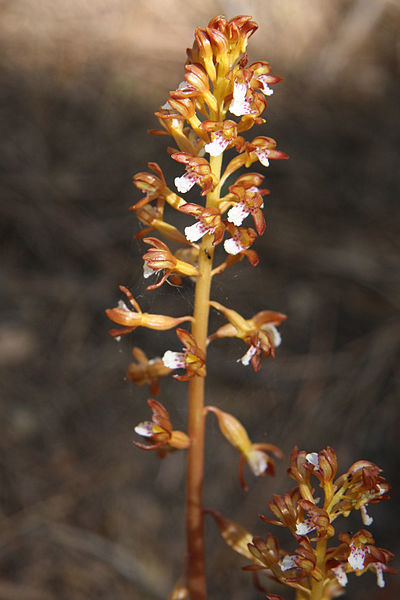Based on the mode of nutrition, orchids are categorized into: epiphytes, terrestrials and saprophytes. Epiphytic orchids as well as terrestrial orchids are preferred by the growers, but saprophytic orchids are least preferred. These orchids are mostly seen growing in research facilities and not in nurseries, because researcher mainly focus on their conservation and to use them as research material, while nurseries don't find them profitable enough. As most of the time saprophytic orchids survive by remaining hidden underground, in form of rhizomes or fleshy tubers, which serve as food reservoir as well as place from where the new growth arises; and the above ground parts grow out only at the time of flowering.
The saprophytic orchids grow in the soils which lack nitrogenous compounds, so to fulfil their nutrition requirement they have adapted to a different way of nutrition. This mode of nutrition has also made them to change their morphological structure; their leaves are reduced to mere scales. Saprophytes such as some of the Corallorhiza species lack chlorophyll and are mostly leafless. They get their nutrition with the help of mycorrhizal fungi; which is present in the soil and within the root cells. Saprophytic orchids do not possess true roots, instead have rhizomatous or fleshy fibrous roots.
When the time comes the resting underground parts sends out flowering shoots. Flowers of these orchids are no less than other orchids; and some just as beautiful. These are also known not to flower every year. One good thing about saprophytes is that they are not affected by pest and diseases that are common to other orchids. Existing most of the time underground, saprophytes escape many infections and pests which infect the above ground parts such as stem and leaves.
A lot of patience is required to grow saprophytes. Caring for saprophytes is also much easier as they do not require much attention. Apart from keeping an eye on rotting of the underground parts, watering is not required frequently. These mostly prefer to grow in leaf litter and depending upon the natural growth habit; they may or may not require sunlight.
 Spotted coralroot (Corallorhiza maculata) closeup, saprophytic orchid with small brownish flowers, pink-spotted white lip.
Photography credit: Jane Shelby Richardson
Spotted coralroot (Corallorhiza maculata) closeup, saprophytic orchid with small brownish flowers, pink-spotted white lip.
Photography credit: Jane Shelby Richardson
Saprophytic Orchids
Curiosityby Anu Dharmani
Originally published in BellaOnline
Posted by Sys Admin over 7 years ago.Article Blog Article Index
Share on Social Media:
New Topics
- John Urey asked question Blooming Stenglottis Venus “jamboree “ in category General Discussion
- Claudia Young asked question RO system in category General Discussion
- Roberto Lizama asked question Help to identify in category General Discussion
- Tatjana Opekunova asked question Cattleya new roots and Flower buds in category Cattleya Alliance
- Mary Lane asked question Orchid roots .com site? in category General Discussion
New Comments
- Jeanne Uzar Hudson commented on member plant Lc. Canhamiana var. coerulea 'Cobalt' by Jeanne Uzar Hudson
- Jeanne Uzar Hudson commented on member plant Sns. gemmata by Jeanne Uzar Hudson
- Stefan Neher commented on topic "Orchid roots .com site?" by Mary Lane
- Kevin Barry commented on member plant Bul. Tammie Sue Pernas by Tony Pernas
- Linda Hartman commented on member plant Ctt. Final Blue by Linda Hartman
- Kevin Bergeson commented on member plant Paph. rothschildianum by Kevin Bergeson
- Carol Holdren commented on topic "recently purchased orchid shows unstoppable roots " by David George
- Michael Makio commented on orchid V. Beatrice Makio
- Carol Holdren commented on topic "shorter stem with less vigorous blooms" by katherine mott
- Carol Holdren commented on topic "need info on yellow bird" by Glenda Ratliff
- Carol Holdren commented on topic "Looking to join an orchid club." by Paula Milano
- Jeanne Uzar Hudson commented on topic "Repotting Large Cattleyas" by Jeanne Uzar Hudson
- Jeanne Uzar Hudson commented on member plant Paph. malipoense by Jeanne Uzar Hudson
- William Gorski commented on topic "how difficult is it growing from seed" by kevan gregory
- Carol Holdren commented on topic "Information " by Carmen Britton
- Carol Holdren commented on member plant C. lueddemanniana var. Coerulea, Venosa by Paulo Fiuza
- Jeanne Uzar Hudson commented on topic "Banrot 40WP" by Therese Stecher
- Maria Lucia Prieto Real commented on orchid Rlc. Village Chief Armani
- Mariana Chacon commented on orchid Gom. Jiaho Queen
- Roberto Lizama commented on member plant Max. dillonii by Roberto Lizama